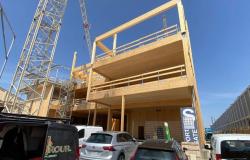Two mournful episodes that not even the atrocity of a war can justify – which occurred in 1944 a stone’s throw from Forlì – come back to life in Roberta Ravaioli’s book ‘The massacres of Branzolino and San Tomè’ (Mdm editions, 13 euros) which will be presented Saturday at 5pm at the Shrine of the Fallen in Corso Diaz 95. The initiative is part of the Liberation Day celebrations.
The origin of the book dates back to April 25th, 14 years ago, when the author held a conference on concentration camps and concentration camps in Germany. Precisely that day, the mayor of the German city of Greven arrived in Forlì, from which second lieutenant Heinrich Nordhorn came, the one who gave the order to kill, by hanging, the ten people involved in the two episodes. There were several citizens who witnessed the events of 1944, still alive at the time, who invited Roberta to tell their stories and report their testimonies.
The author – 68 years old, a retired teacher and school director – thus began to carry out interviews and jot down notes of episodes and stories of those tragic days: narratives that are very much alive. But then, busy with work, she put the whole package in a drawer which was not reopened until September 2023. When, on the occasion of the 79th anniversary of the deaths of San Tomè, Roberta was convinced by the historian Mario Proli to reopen that famous drawer : “All those I spoke to – he explains –, whether they were direct witnesses of those events, or children or grandchildren, couldn’t help but hold back their tears as they remembered what happened.”
The book tells of ten deaths, four in Branzolino and six in San Tomè, hanged by the Nazis in two sadly similar episodes that occurred 12 days apart. On the evening of 27 August 1944, a sabotage action presumably carried out by partisans against Nazi troops caused an attack which seriously injured a German motorcyclist. The reaction of the SS was immediate. The soldiers went to the Viale Salinatore prison (in the building that now houses the Employment Centre), took six anti-fascist citizens suspected of being part of the partisan cell that existed at the Orsi-Mangelli factory and took them to Branzolino. In the meantime, other German soldiers had rounded up 50 men in the countryside, mostly farmers, who were forced to witness the hanging of the four prisoners: Secondo Cervetti, 37 years old, Ferdinando Dell’Amore, 38 years old, Ivo Gamberini, 38, and Giovanni Golfarelli, 33 years. At that point the German command issued a warning decreeing that if there was another attack, all the men of the hamlet would be killed, the houses would be set on fire and the women and children deported to Germany.
Eleven days later, in San Tomè, a short distance away, a bomb explosion seriously injured an Italian man, who in the middle of the night had left his house, violating the curfew, to look for a midwife because his wife was about to give birth, but also a German soldier. Even on this occasion the script was the same: roundup of 250 citizens who were forced to witness the hanging of six other men: four prisoners and two Jews, father and son. The prisoners were Celso Foietta aged 37, Antonio Gori, known as Natale, aged 26, Michele Mosconi aged 39 and Antonio Zaccarelli aged 19. The two Jews, captured in Castelbolognese, were named Emilio and Massimo Zamorani aged 54 and 25 years old. Second Lieutenant Heinrich Norhorn, convicted in 2006 by a military court, died in 2015 at the age of 96. For reasons of age, he never went to prison.
Roberta Ravaioli’s book is a further concrete sign of a memory that must never forget certain facts.
Stefano Benzoni





